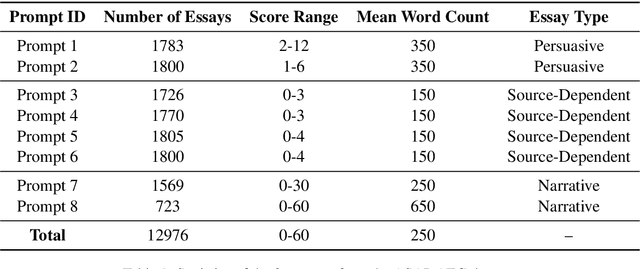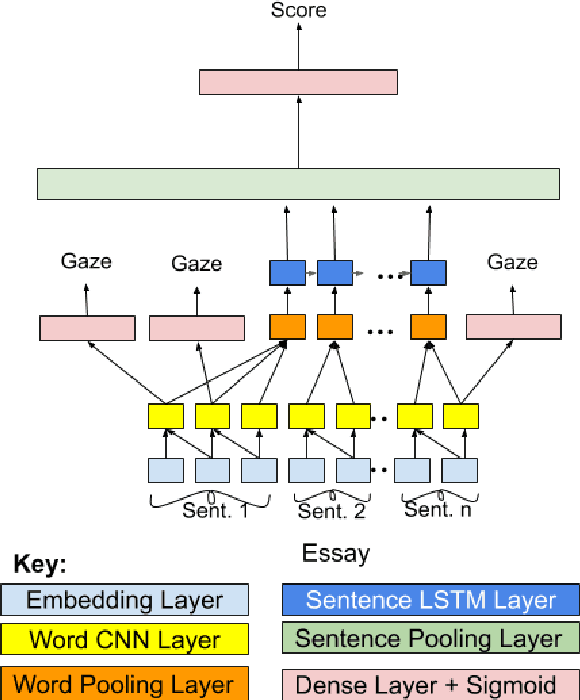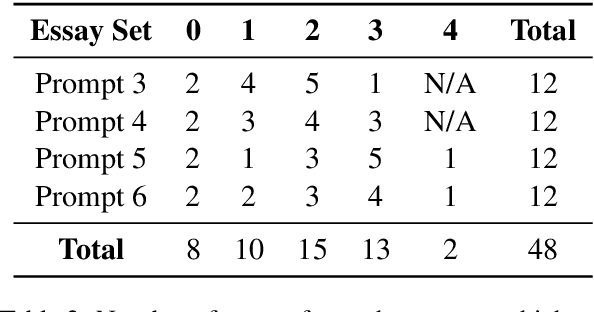Sandeep Mathias
A Survey on Using Gaze Behaviour for Natural Language Processing
Jan 03, 2022


Abstract:Gaze behaviour has been used as a way to gather cognitive information for a number of years. In this paper, we discuss the use of gaze behaviour in solving different tasks in natural language processing (NLP) without having to record it at test time. This is because the collection of gaze behaviour is a costly task, both in terms of time and money. Hence, in this paper, we focus on research done to alleviate the need for recording gaze behaviour at run time. We also mention different eye tracking corpora in multiple languages, which are currently available and can be used in natural language processing. We conclude our paper by discussing applications in a domain - education - and how learning gaze behaviour can help in solving the tasks of complex word identification and automatic essay grading.
Cognitively Aided Zero-Shot Automatic Essay Grading
Feb 22, 2021



Abstract:Automatic essay grading (AEG) is a process in which machines assign a grade to an essay written in response to a topic, called the prompt. Zero-shot AEG is when we train a system to grade essays written to a new prompt which was not present in our training data. In this paper, we describe a solution to the problem of zero-shot automatic essay grading, using cognitive information, in the form of gaze behaviour. Our experiments show that using gaze behaviour helps in improving the performance of AEG systems, especially when we provide a new essay written in response to a new prompt for scoring, by an average of almost 5 percentage points of QWK.
Many Hands Make Light Work: Using Essay Traits to Automatically Score Essays
Feb 01, 2021



Abstract:Most research in the area of automatic essay grading (AEG) is geared towards scoring the essay holistically while there has also been some work done on scoring individual essay traits. In this paper, we describe a way to score essays holistically using a multi-task learning (MTL) approach, where scoring the essay holistically is the primary task, and scoring the essay traits is the auxiliary task. We compare our results with a single-task learning (STL) approach, using both LSTMs and BiLSTMs. We also compare our results of the auxiliary task with such tasks done in other AEG systems. To find out which traits work best for different types of essays, we conduct ablation tests for each of the essay traits. We also report the runtime and number of training parameters for each system. We find that MTL-based BiLSTM system gives the best results for scoring the essay holistically, as well as performing well on scoring the essay traits.
Happy Are Those Who Grade without Seeing: A Multi-Task Learning Approach to Grade Essays Using Gaze Behaviour
May 25, 2020



Abstract:The gaze behaviour of a reader is helpful in solving several NLP tasks such as automatic essay grading, named entity recognition, sarcasm detection $\textit{etc.}$ However, collecting gaze behaviour from readers is costly in terms of time and money. In this paper, we propose a way to improve automatic essay grading using gaze behaviour, where the gaze features are learnt at run time using a multi-task learning framework. To demonstrate the efficacy of this multi-task learning based approach to automatic essay grading, we collect gaze behaviour for 48 essays across 4 essay sets, and learn gaze behaviour for the rest of the essays, numbering over 7000 essays. Using the learnt gaze behaviour, we can achieve a statistically significant improvement in performance over the state-of-the-art system for the essay sets where we have gaze data. We also achieve a statistically significant improvement for 4 other essay sets, numbering about 6000 essays, where we have no gaze behaviour data available. Our approach establishes that learning gaze behaviour improves automatic essay grading.
Eyes are the Windows to the Soul: Predicting the Rating of Text Quality Using Gaze Behaviour
Oct 11, 2018



Abstract:Predicting a reader's rating of text quality is a challenging task that involves estimating different subjective aspects of the text, like structure, clarity, etc. Such subjective aspects are better handled using cognitive information. One such source of cognitive information is gaze behaviour. In this paper, we show that gaze behaviour does indeed help in effectively predicting the rating of text quality. To do this, we first model text quality as a function of three properties - organization, coherence and cohesion. Then, we demonstrate how capturing gaze behaviour helps in predicting each of these properties, and hence the overall quality, by reporting improvements obtained by adding gaze features to traditional textual features for score prediction. We also hypothesize that if a reader has fully understood the text, the corresponding gaze behaviour would give a better indication of the assigned rating, as opposed to partial understanding. Our experiments validate this hypothesis by showing greater agreement between the given rating and the predicted rating when the reader has a full understanding of the text.
 Add to Chrome
Add to Chrome Add to Firefox
Add to Firefox Add to Edge
Add to Edge